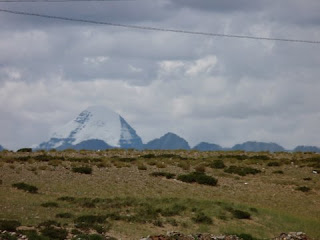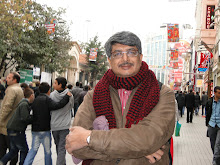
Hotel Saga was a welcome relief to us but is a civil engineers nightmare. The steps are irregular and was probably constructed by students whose foundations were not yet cemented.

A view of the entrance and the reception within. The only proper hotel on the entire circuit.

A one street wonder with a huge military camp. Soldiers keep strutting around with over-sized miltary caps.

The spot where we stopped for lunch. The grounds beyond the street were once withness to the unholy massacre of Tibetans whilst the mountains at the very end hid the Tibetans on their escape to Nepal.

Lunch being unpacked for the not-so-hungry yatris.

These structures have witnessed the bloody past but have gone silent now.

A stupa sitting pretty on top of a hill near about the same spot.

The Divine Spectacle.....What an amazing phenomenon?

Note the clear skies all around and the sun partially hidden by the roof at a petrol station.

A slightly more audacious attempt. The sun shining brightly and it was pure light....only light.

Grasslands after miles of desolate landscape...the second surprise.

....and sand dunes against the backdrop of a completely bald hill.

See the Creators magic. His imagination ran wild...shrub land followed by sand dunes and then a river, hills and mountains.

A closer look at this collage...it was enough to send us to the high heavens...I was ecstatic.

Our jeeps in the distance dwarfed by mountains on the other side.

Authentic sand dunes....reminds me of Rajasthan or the Desert Safari at Dubai.

That's me spending a quiet moment and contemplating on these rare sights.

That was perhaps some unfortunate yak which landed on some poor villager's table.
It now serves by scaring away all "evil spirits" from the vicinity.

That is the traditional Tibetan house built with stones, clay and dung.....

Our guest house whose claim to fame was a shower facility, though kept locked and away from any visitor.
 Kailash hiding behind a thick cloud cover
Kailash hiding behind a thick cloud cover We see both Kailash and Nandi Parbat here and the clouds have still not stirred. Nandi Parbat was about forty five minutes from where we stood and Kailash maybe an hour or two further.
We see both Kailash and Nandi Parbat here and the clouds have still not stirred. Nandi Parbat was about forty five minutes from where we stood and Kailash maybe an hour or two further. Resting after a strenuous climb.
Resting after a strenuous climb. Another angle to the whole thing.
Another angle to the whole thing. That's the Mumbai team with Autar and Neema our Sherpas.
That's the Mumbai team with Autar and Neema our Sherpas. See that!...Our jeeps are small specks (right central of the photograph) and we climbed all the way up.
See that!...Our jeeps are small specks (right central of the photograph) and we climbed all the way up. Serlung gompa
Serlung gompa Stupa outside the gompa.
Stupa outside the gompa. Guru Rinpoche is worshipped here.
Guru Rinpoche is worshipped here. Another view of Guruji.
Another view of Guruji. There it is.....with no clouds to hide its grandeur.
There it is.....with no clouds to hide its grandeur. Descending down to our jeep park.
Descending down to our jeep park. A close-up of the royal Tibetan beast.
A close-up of the royal Tibetan beast.




















































